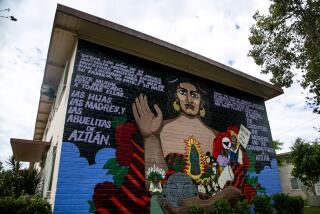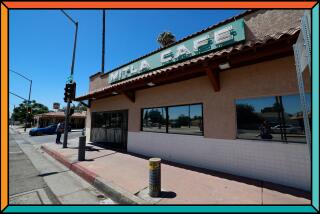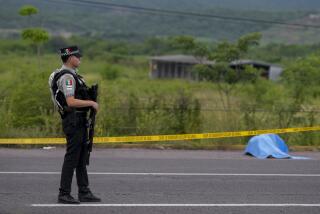Mexico’s Little Americas’
- Share via
CIUDAD NEZAHUALCOYOTL, MEXICO — No one knows exactly what Hector “El Rosado” Huaracha was thinking when he turned the corner at Fourth and walked northward up Gardenia. The 17-year-old founding member of La Primera gang knew exactly where Primera’s territory ended and Florencia’s began. Not far from the corner, two homeboys from Rosado’s rival barrio were sitting inside a white Ford pickup parked at the curb. Swinging his arms wide and jutting his chin high, Rosado kept walking toward them.
The Florencia boys were as surprised as anyone that a Primera homeboy would so brazenly violate their territory. They challenged him immediately. Rosado did not back down. Profanities and hand signs were traded. Then Rosado did something that can only be described as suicidal. Unarmed and in the middle of hostile gang territory, he yanked open the pickup door and flung himself, fists flying, onto the two Florencia kids. About a minute later, Rosado lay on the sidewalk with bullet wounds in the chest and abdomen. By the time the ambulance arrived about 20 minutes later, he was dead.
A typical gang story in L.A.? Yes. But Hector Huaracha was killed on Feb. 5, 1997, in Ciudad Nezahualcoyotl, one of Mexico City’s largest suburbs (population figures range from an official count of 1.2 million to guesstimates of more than 4 million).
While many Americans express concern about the social and economic impact of the presence of Mexican migrants in the United States, they see only half the equation of what is, after all, a binational relationship. Mexico, too, is being transformed in this era of free trade and global culture: It is on the receiving end of a tremendous amount of cultural influence from the United States, for better and worse. For the working-class teens of places like Nezahualcoyotl, it is becoming a matter of life and death.
In “Neza,” as locals refer to their city (in the pre-Columbian Nahuatl language, the unabbreviated word means “‘hungry coyote”), there are few high-rise apartment buildings or vecindades, the crowded courtyards so popular in Mexico City. Residential streets, lined almost exclusively with single-family dwellings, are wide swaths of asphalt. Neza’s perfectly planned neighborhoods are square grids divided by major avenues. In many ways, Neza is a Mexican working-class version of the San Fernando Valley. Many of the pioneers of Neza came from poor neighborhoods in the capital, looking for the better life.
I didn’t expect to hear about a gang-related death or witness a crew of L.A.-style cholos prepare a drive-by retaliation when I arrived in Neza. Pablo Hernandez, a young cultural activist and former punk rocker who lives in the municipality, had simply told me that L.A.’s barrio style--baggies and bandannas, oldies and hip-hop music, graffiti--was taking root there.
“These kids are swallowing U.S. culture whole, and they’re losing important elements of their own culture,” says Hernandez. “They’ll see a movie like ‘American Me’ on video and then act it out in real life. People talk about free trade and immigration all the time, but they never talk about the impact of all this movement on the kids.”
Walk through the streets of practically any neighborhood in Neza and you’ll find signs of U.S. street gang culture. Graffiti tagging is ubiquitous, demarcating territories of gangs whose names are inspired by the lore of barrios in Southern California, names like Primera and Florencia, along with 18th Street, Mara Salvatrucha, Echo Park 13. Kids in full “‘cholo” regalia gather at street corners after dusk, blasting hip-hop music or oldies from car stereos and boom boxes. Drugs like crack cocaine have taken their place along side the more typical poor-kid’s high of sniffed glue or spray paint.
A major difference between L.A.’s gang wars and Neza’s is that, although drug abuse is rampant here, the violence, for the moment, is not about the drug trade. (There are many small-time dealers in Neza, but they do not tend to be gang members, who are more often the customers.) Still, the gangs of Neza claim “barrios” and guard them with their lives. It is as if they are saying that their neighborhood, their block, their homes are all they have left in a society whose economy is in tatters and whose cultural identity is undergoing a seismic shift.
I met Primera founder Jonathon “Viruta” Garduno shortly after Rosado’s death. He told me the story of how the barrio came to Neza. A restless 18-year-old from a broken home, he’d made a trip to Los Angeles, where he stayed with relatives on Garvey Street on the Eastside. He came back only a few months later, completely transformed: wearing cholo dress, speaking Spanish peppered with pochismos (Anglicisms and neologisms combining the two tongues), and proudly carrying videos of films like “American Me,” “Bound by Honor” and “Zoot Suit.” The Primera gang was founded in the spring of 1995 (its members claim it was the first cholo-style gang in Neza, hence its name), not long after Viruta’s return from Los Angeles. The first drive-by shooting, which was perpetrated by the Mara Salvatrucha gang against Primera, occurred in September of that year, gang members say.
Most of the Primera members, and most of the other gang kids in Neza, for that matter, have not traveled to the United States. They have gleaned the culture from the few kids who have, and from what they see in Hollywood’s renditions of life in the north. (Virtually every family in Neza has a VCR and cable TV, if not a satellite dish.)
The violence in Neza has led to at least one death, Rosado’s, and, according to Primera members, about a half-dozen gun-related injuries. “Our saying is, ‘Always forward, never back,’ ” Viruta says. His notion of the future for the youth of Neza is as fatalistic as that of any hard-core gang member from Boyle Heights. “You live and die for the barrio.”
The Chicano style has been noticeable for some time in the provincial cities and towns of Southwestern and Northern Mexico, in states like Jalisco, Michoacan, Zacatecas and Guanajuato, the places with the highest rates of immigration to the United States. Mexico City and its ever-expanding suburbs had remained largely untouched by this kind of influence in part because its imigration rates, historically, had been lower than in the rural areas.
But with the economic crisis touched off by the devaluation of the peso in December 1994, people in and around Mexico City have been forced to travel the migrant routes northward. Each Mexican arriving in the United States adds weight to the cultural fulcrum that transforms parts of U.S. cities into “little Mexicos”; each Mexican returning brings a bit of America home.
There are no official estimates of the numbers of gangs in Neza, but according to the founders of Primera, there is at least one “clika” (clique) per neighborhood--there are 85 in the entire city--meaning there could be well more than 1,000 gang members. Officials of the Party of the Democratic Revolution (PRD) in the municipal government in Neza, meanwhile, are dealing with the legacy of massive corruption and grossly inadequate services of the past administration (there were 242 officers on the police force as of last spring, but only 80 pistols and 56 patrol cars for Neza’s 85 districts). There is no gang unit or even much awareness of the problem other than in its cultural sense.
The explosion of Chicano-style gangs is only the latest in a string of U.S.-influenced youth movements here. Throughout the ‘70s and ‘80s, kids in Neza appropriated a variety of styles. The punk version of gangs known as chavos banda (literally, “kids of the gang”) first appeared in the early 1980s; they styled themselves after the anarchic tendencies of the British punk band The Sex Pistols. There were fans of the glam-rock band Kiss who painted their faces black and white and wore five-inch platform heels, and heavy-metal kids with hair cascading down their shoulders. Others were inspired by ‘60s mainstays like The Doors and the Rolling Stones. Skateboard fashion arrived in the early ‘90s.
It is no surprise today in Mexico to see kids with tattoos, pierced navels or noses, and worn flannel shirts cavorting down the streets, right past mendicant Indians wearing their millennial dress. The dramatic increase in immigration to the United States, along with the effects of globalized capital and media, has accelerated and intensified the process of what anthropologists call cultural syncretism.
Needless to say, there is an upside to this exchange as well. American pop culture, particularly rock ‘n’ roll, has given Mexico’s youth a long-needed dose of healthy, rebellious individualism--and its attendant optimism. All this goes hand-in-glove with the process of democratization that the entire country is currently undergoing. Tolerance of alternative lifestyles was never Mexico’s forte; the breaking up of what used to be an artificially hegemonic culture (the legacy of the nationalist revolution here) is helping Mexico fashion a new, global sense of itself.
But the increase in gang violence in Neza is an indicator of the risks in an era of ceaseless movement of capital, culture and people across borders. In a bitter irony, many families, precisely because of the migrations they undertook to ensure their survival, have begun to disintegrate. Dad might not be heard from again after he leaves for the job in the States. Or, both parents might leave the kids behind with grandparents. As the family comes apart, children are lost in the shuffle and begin to act out their frustrations on the streets among themselves.
In the end, despite the seeming disappearance of barriers, some important ones remain. Children can only deal with the world with the tools that adults give them. Whether in San Jose or San Salvador, L.A. or Neza, today’s kids appear to have fallen into the invisible borders between churning economies, on the one hand, and the creation of a global underclass, on the other.
In Neza in the early ‘80s, it was not uncommon for punk rockers, hippies and disco kids to face off in relatively innocent street battles. Now and again, a switchblade appeared, but getting yourself killed over a style spat was about as probable as a lightning strike.
At the spot where Hector Huaracha died, on the sidewalk where the stain of his blood has faded to a tannish brown, there is a white paint bucket in which votive candles burn day and night, sheltered from the dusty winds that blow in Neza through the summer months. On this darkening urban landscape, the children’s lives appear as fragile as those candle flames, now that lightning has struck in Neza.
More to Read
Sign up for Essential California
The most important California stories and recommendations in your inbox every morning.
You may occasionally receive promotional content from the Los Angeles Times.










